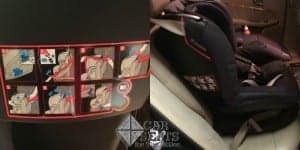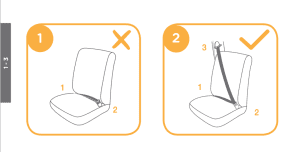Fashion. Currencies. Road signs. Wines. Cars. The metric system. There are many differences between Europe and the United States. Including car seats.
As with wines and cars, many caregivers think European car seat brands are better or safer than their United States counterparts. However, just as wines and cars are actually pretty equal, so are car seats. Here’s a look at a few of the key differences.
Testing Speed

Rear facing versus forward facing sled test, thanks to UMTRI. https://www.youtube.com/watch?v=ziItesP2dS8
Car seats that are designed for the European market are subject to a different type of testing than seats sold in the United States market. This can be a little confusing for caregivers who are searching for the “safest” seat for their Little. One source of confusion is the speed of the test — at first glance it seems that European testing is done at 50 mph, rather than the United States’ 30 mph.
However, that’s not quite the case. European testing requires (ECE R44 and ECE R129) a sled test done at 50 kilometers per hour (km/h) not 50 miles per hour (mph). Conversely, United States testing (FMVSS213) requires a sled test at 48 km/h. To translate both test speeds into miles per hour: European testing is done at 31 mph, and United States testing is done at 30 mph.
In a sled test, the car seat is installed on a representative back seat and then accelerated (some go forward, some go back), followed by a simulated crash.
Side Impact Testing
Europe has side impact standards for their car seats and boosters.The United States has proposed standards (http://www.nhtsa.gov/About+NHTSA/Press+Releases/NHTSA+Proposes+First-Ever+Side+Impact+Test+for+Child+Restraint+Systems), but currently has no required side impact testing. What does that mean for car seats labeled with “Side Impact Tested”?
Some car seat manufacturers test to their own standards, others test to the proposed standards (which may change before they ever become final). Because of these differences between companies, there’s really no way to tell what side impact testing in the United States means, since we may be comparing apples to oranges. In Europe, though, standardized side impact testing for car seats is required. These standards were adopted fairly recently with the 2013 i-Size regulation changes.
Whether you buy an American, European, Asian, or other brand of seat, all seats sold to the United States market are tested to United States standards. There is no benefit to buying a RECARO (German-based company), for instance, over a Graco (American-based company) when it comes to testing. All seats sold in the United States are tested to United States standards for use in the United States market.
Other Differences

A Little in a European car seat by Audi (note the lack of chest clip).
European standards require that seats allow a parent to release the harness in a single motion. That means that their harnesses do not have a chest clip (please note: this does not mean they are three point harnesses, the five points of a harness are both shoulders, both hips, and a crotch strap). Again, as with the testing standards, this difference in design doesn’t mean one is better than another, just that they’re slightly different. An American seat uses the chest clip to keep the straps properly placed on the shoulders: if the chest clip is too low the straps can be too wide on the shoulders. If it’s too high, it can be in the way of the child’s throat. In Europe, they use a more angled set of straps and often grippy shoulder strap covers to keep the straps on a child’s shoulders. Both harnesses restrain the child during the crash properly, just in different ways.

Rigid lower anchors, also called ISOFIX in Europe. They reduce head excursion on harnessed seats in a similar way to a top tether.
Only since 2013 have European car seats come equipped with top tethers, and since the 2014 model year European cars have come with tether anchors. This is a new regulation with the i-Size requirements of ECE R129. European car seats had previously used rigid lower anchors, ISOFIX, to reduce head excursion. Car seats in the United States have used a top tether for that reason since September 1999. These are simply different ways to reduce head excursion. Some European car seats also have used load legs, even with forward facing car seats, to reduce forward movement and head excursion.

The Maxi Cosi Tobi, showing the instructions for installation using a serpentine belt path and lockoffs. Then shown properly installed.
Because cars in the European market are not required to have seat belts that lock before a crash, European seats tend to have a serpentine routing, lockoffs, or both so they can lock the belt. Again, this doesn’t mean if you buy a Mercedes in the United States it won’t have locking belts; it will because it’s being made for the US market, even though it’s a German car.

Joie Stages manual showing the car seat can be installed only with a lap and shoulder belt, not a lap belt, and there is no ISOFIX.
American seats can be installed with a lap belt only, lap and shoulder belt only, seatbelt and top tether, or lower anchors and top tether. It’s not always easy, but all American harnessed seats can be installed in those four ways. European seats, though, may be very specific as to how they can be installed. Some may be ISOFIX only, others are a lap and shoulder belt only. Many do not allow an install with a lap belt only (which means they cannot be used on a plane like nearly all American harnessed seats can).
Travel Abroad
For Americans traveling abroad, your car seat can be used in a foreign car, but you may need a locking clip since most seats in the United States don’t have a serpentine routing or lockoff. However, many seats in the United States without lockoffs are not being sold with locking clips anymore. This is to save money and weight by the manufacturers since most cars in the United States have belts that lock before a crash and lower anchors; locking clips are very rarely necessary for use in the United States. If your brand new car seat did not come with a locking clip and you need one, please contact your manufacturer; they will still provide one. For information on the legalities of traveling internationally with a car seat, please read our Traveling Internationally with Littles article.
With any car seat, the important thing to keep your child safe is to use a car seat that is the best for your child’s size, for your car’s size/shape, that fits in your budget the best, and that you can use properly 100% of the time.
If you live in Europe, your child will use a European car seat. If you live in the United States, your child will use an American car seat. If you live in Canada, your child will use a Canadian car seat. And you’ll know that despite design differences those seats have all passed very very strict testing and are safe to use.
